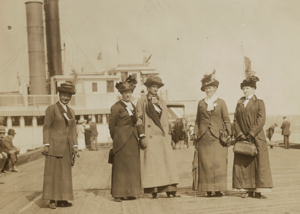Our website is made possible by displaying online advertisements to our visitors.
Please consider supporting us by disabling your ad blocker.
Anti-suffragism

Anti-suffragism was a political movement composed of both men and women that began in the late 19th century in order to campaign against women's suffrage in countries such as Australia, Canada, Ireland, the United Kingdom and the United States. To some extent, Anti-suffragism was a Classical Conservative movement that sought to keep the status quo for women. More American women organized against their own right to vote than in favor of it, until 1916.[1] Anti-suffragism was associated with "domestic feminism," the belief that women had the right to complete freedom within the home. In the United States, these activists were often referred to as "remonstrants" or "antis."
- ^ Miller, Joe C. "Never a Fight of Woman Against Man: What Textbooks Don't Say about Women's Suffrage". suffrageandthemedia.org. The History Teacher. Retrieved 2022-12-24.
Previous Page Next Page


